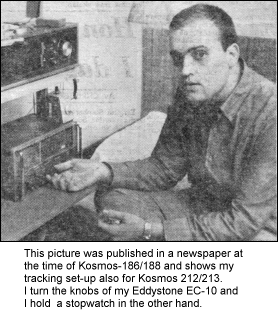 Radio
observations of Kosmos-212/213 - the second automatic docking
Radio
observations of Kosmos-212/213 - the second automatic docking Radio
observations of Kosmos-212/213 - the second automatic docking
Radio
observations of Kosmos-212/213 - the second automatic docking
On Tuesday 2 April 1968,
Swedish media reported rumors from Belgrade that a "group flight" with
Gagarin at the helm would take place near 12 April - Cosmonautics Day
(1).They
got the date almost right and they also got the mission right, but not
the crew!
Sunday,
14 April 1968
At 1000 UT, Kosmos-212,
the unmanned 7K-OK #8 Soyuz ship, was launched from
Baikonur
to work as the active ship in the attempt to achieve an automatic
rendezvous
and possibly docking with another, similar, ship to be launched a day
later.
TASS did announce the flight and I heard the news about the launch at
1400
UT when radio Sweden mentioned the launch in its regular news bulletin.
Since I had listened all day on 19.995 MHz without hearing anything I
concluded
that this satellite was not a normal reconnaissance Kosmos satellite. I
therefore tuned the "Soyuz" frequency of 20.008 MHz starting at 1415
UT.
I did not have to wait long for at 1459.25 UT I picked up the typical
Soyuz
CW-PDM
telemetry. Another Soviet space spectacular was underway! The signals
lasted
until 1528.30 UT and the spacecraft passed the antipode during this
reception.
Short-wave propagation conditions were exceptional. The next pass
lasted
almost 45 minutes from 1609.15 until 1653.30 UT. During the next pass
at
1737.02-1744.02 UT the signal was commanded off just after having
increased
sharply in strength.
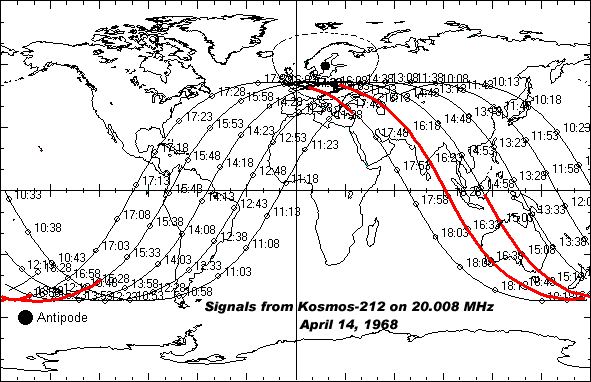 I
telephoned Geoff Perry to
report
my observations at 1900 UT. In the evening I picked up BBC Midlands to
hear Geoff Perry of the Kettering
Grammar
School saying that "this indicates a space spectacular". (Listen here
for another BBC report about the School's tracking of Kosmos-212).
In the evening I also heard a transmission from RIAS-Berlin (RIAS=Radio
In American Sector) reporting that professor Kaminski at the Bochum
radio
observatory had picked up voice (!) signals which could have come from
Kosmos-212 and that the ground controller was female! It seems that the
Bochum observatory greatly overinterpreted something they had heard on
short waves!
I
telephoned Geoff Perry to
report
my observations at 1900 UT. In the evening I picked up BBC Midlands to
hear Geoff Perry of the Kettering
Grammar
School saying that "this indicates a space spectacular". (Listen here
for another BBC report about the School's tracking of Kosmos-212).
In the evening I also heard a transmission from RIAS-Berlin (RIAS=Radio
In American Sector) reporting that professor Kaminski at the Bochum
radio
observatory had picked up voice (!) signals which could have come from
Kosmos-212 and that the ground controller was female! It seems that the
Bochum observatory greatly overinterpreted something they had heard on
short waves!
In (2) Boris Chertok describes what happened behind the official news "smokescreen" as he experienced from the control center at Yevpatoria where he was the deputy flight director. On revolution 5 there was a slight orbit maneuver. Everything seemed normal until telemetry was being analyzed. It seemed that occasionally the low thrust orientation engines were used for attitude control. These had a ten times lower thrust than the main attitude control thrusters and were intended for vernier control at close range during docking.
Their intermittent use threatened to deplete the propellant according to the analysts who argued that the launch of the second spacecraft should be delayed. This argument was advanced as late as two hours before the intended lift-off. Chertok hurriedly organized short-wave radio conversations with Rauschenbach back in Moscow and the state commission still at Baikonur. Finally, after much discussions and formalistic exchanges, the control team could send a telegram to Baikonur recommending that the second spacecraft be launched.
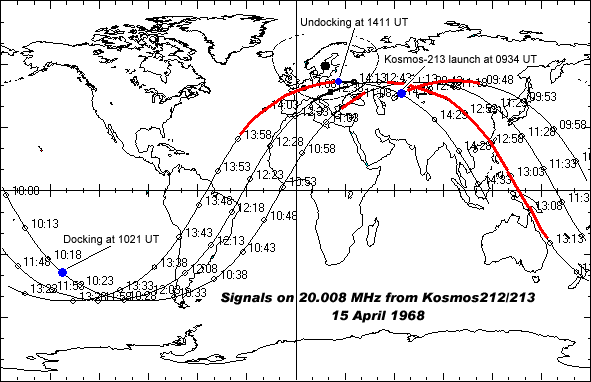 For
me the day started with terrible interference on the Soyuz frequency
during
the first two passes. Strong signals picked up at 0940.58-0948.00 UT.
These
signals must have come from Kosmos-212 because signals on shortwaves
normally
started 10 minutes after launch of a Soyuz when short-wave antennas
deployed.
At the time when these signals started Kosmos-213 was still attached to
the launch vehicle which was accelerating towards orbit. After these
signals,
at 1021 UT, the docking took place according to TASS reports at the
time
(3).
For
me the day started with terrible interference on the Soyuz frequency
during
the first two passes. Strong signals picked up at 0940.58-0948.00 UT.
These
signals must have come from Kosmos-212 because signals on shortwaves
normally
started 10 minutes after launch of a Soyuz when short-wave antennas
deployed.
At the time when these signals started Kosmos-213 was still attached to
the launch vehicle which was accelerating towards orbit. After these
signals,
at 1021 UT, the docking took place according to TASS reports at the
time
(3).
Chertok (2) describes vividly how the two spacecraft passed out of range of the Ussuriysk tracking station in the far east at 0953 UT when they were 335 meters apart. The frustration was great at not knowing what was happening and the staff at Baikonur and Yevpatoria were asking those responsible for the short-wave telemetry for any indication of docking. Finally, at 1021 UT there was great relief when the short-wave stations at Alma-Ata, Novosibirsk and Tashkent all reported that "parameter 2 had reached 100%". This was the sign of electrical connection between the two craft. (More about this below). As the craft came up over the horizon at Yevpatoria the outline of the "passive" ship could be seen in the TV picture from the "active ship". It is fascinating that while all this was happening, I was at my radios!
There were weak signals concealed in heavy interference at 1105.33-1109.10 UT as the two docked spacecraft passed almost directly over Yevpatoria. It was impossible to know from which satellite these signals came. The signals were continuous during these passes, but when they came back at 1244.22 UT they had switched over to the transmission mode with 30-second bursts of pulses at two minute intervals that were first observed from Kosmos-140, The last burst during this pass was heard at 1312.50 UT. A 20-second segment of the signal was heard starting at 1358.32 UT and then another 30-second burst 4 minutes later. After that the 30-second bursts continued regularly until 1410.49 UT. TASS announced at the time that the undocking took place at 1411 UT (3). So, it seems that the short-wave transmission ended at the moment of undocking. No more signals were picked up after that until April 18 (See below). The picture below shows the last two 30-second bursts transmitted before loss of signal at 1410.49. It is interesting to see the more rapid Doppler shift at command-off, which is consistent with the map above. By the way, one can see a short frequency instability at the switch-on of each burst!
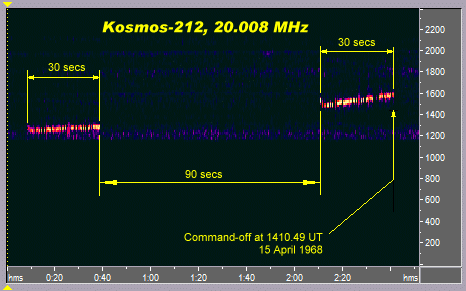
Radio Sweden used a 30-second signal burst that I recorded to illustrate the news item about the docking in their 1730 UT news transmission. The telemetry burst is reproduced below as a spectrogramme. Unfortunately I do not know the exact time that this burst was recorded. It was during the docked phase, though.

No signals had been heard from the Kosmos 212/213 mission since 15 April until three days later. Upon tuning in 20.008 MHz on 18 April I picked up 30-second bursts of telemetry. The lasted from 1629 UT until 1657 UT. That was the last I heard from the mission.
Kosmos-212 landed on 19 April after having carried out the first guided re-entry (using the limited lift coefficient of the Soyuz re-entry vehicle). The vehicle landed near Karaganda in severe winds and was dragged by the parachute over a distance of 5 km. Kosmos 213 came down the following day, also after a flawless guided reentry but was also dragged by its parachute after landing..
"Parameter
2 at 100%"
When reading Chertok's
memoirs
(2)
and its account of how the short-wave telemetry "parameter 2" was used
to verify docking between Kosmos-212 and Kosmos-213, it occurred to me
that perhaps I had recordings that could show the value of this data
word.
I could not find any accurately annotated tape recording of signals
from
this mission (the graph of the signal above is indeed telemrty from the
docked phase of Kosmos-212/213, but the exact time is unknown), but I
found
pen recordings of 20.008 MHz telemetry from both Kosmos-186/188 and
Kosmos-212/213.
These are shown below.
The strip chart
recording
from Kosmos-186/188 was made while the two craft were undocked
(and they were never "electrically" docked) while the recording from
Kosmos212/213
was made while the two spacecraft were "electrically" docked.
And - indeed there are two words in the telemetry frames (the CW-PDM
frame
contains 15 words - all are not shown below) that are different between
the two missions word 2 and 3. All other are practically at the same
reading
(see table on the right side of the strip chart recording). Word #2 was
at a low value and #3 at a high value, while the opposite was true for
Kosmos-186/188. So, it seems that these two values could be the reverse
of each other and that 100% value of word #2 was represented by a low
reading!
In any case word 2 is different between the two missions and situations
(undocked/docked).
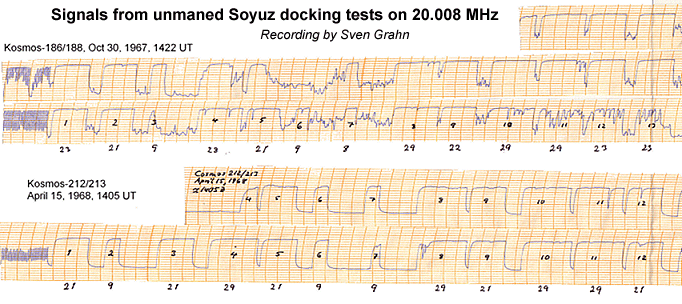 |
 |
P.S.
After having written this
article in November 2003 I have located all my old reel-to-reel tape
recordings
and found well-documented recordings of signals from the Kosmos-212/213
mission. Of course it is difficult to know if all signals come from the
same spacecraft. Anyhow, below is a figure that shows the sync signal
and
the three first words in the telemetry frame. The top signal is from 14
April and the lower one is from 15 April just before the undocking.
Possibly,
what we call word 1, i.e. the first word after the sync train is the
one
the Russians call word 2, denoting the sync signal as word 1. In that
case
word 2 certainly was at 100% value. However, I have a hard time
explaining
why this word and the one following it had different values in the
figure
above - just five minutes earlier!
